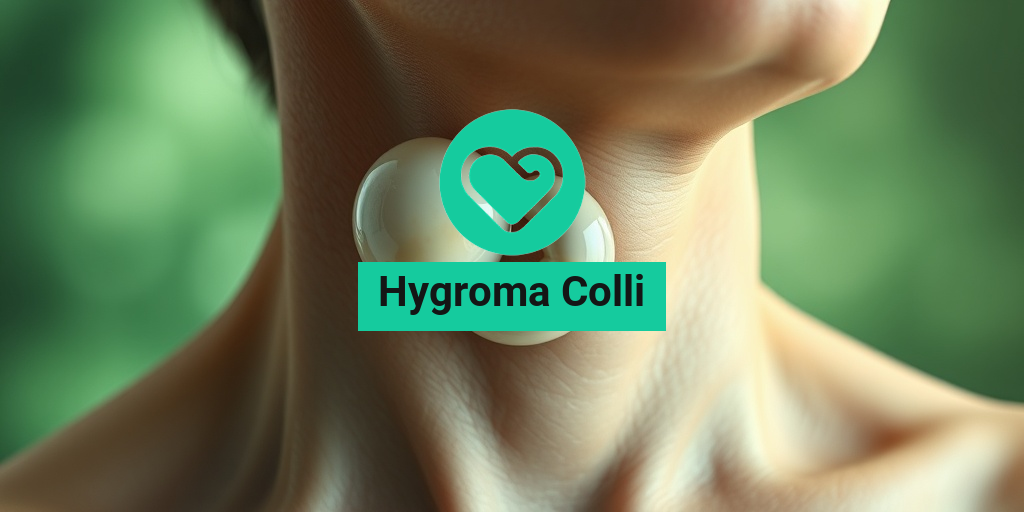What Is Hygroma Colli?
Hygroma Colli is a medical condition characterized by the presence of a cystic mass in the neck region, specifically in the posterior triangle of the neck. This condition is often congenital, meaning it is present at birth, and is typically associated with a lymphatic malformation. The term “hygroma” refers to a fluid-filled sac, while “colli” indicates its location in the neck. These cysts can vary in size and may be filled with lymphatic fluid, leading to swelling and discomfort.
Hygroma colli is most commonly diagnosed in infants and young children, but it can also occur in adults. The condition can be classified into two main types: cystic hygroma and hygroma colli cysticum. Cystic hygromas are larger and can be more complex, while hygroma colli cysticum typically presents as a simpler, smaller cyst.
Causes of Hygroma Colli
The exact cause of hygroma colli is not fully understood, but it is believed to arise from developmental abnormalities in the lymphatic system during fetal development. Factors that may contribute to the formation of hygroma colli include:
- Genetic Factors: Certain genetic syndromes, such as Turner syndrome, are associated with an increased risk of developing hygroma colli.
- Environmental Factors: Maternal infections or exposure to certain medications during pregnancy may also play a role.
- Congenital Anomalies: Other congenital anomalies may coexist with hygroma colli, complicating the clinical picture.
Hygroma Colli Symptoms
The symptoms of hygroma colli can vary depending on the size and location of the cyst. In many cases, the condition may be asymptomatic, especially if the hygroma is small. However, larger cysts can lead to noticeable symptoms, including:
Visible Swelling
One of the most common signs of hygroma colli is a visible swelling or lump in the neck area. This swelling may be soft to the touch and can vary in size. Parents often notice this during routine check-ups or when bathing their child. In adults, the swelling may be less noticeable but can still cause discomfort.
Difficulty Breathing or Swallowing
If the hygroma is large enough, it may compress surrounding structures, leading to difficulty in breathing or swallowing. This can be particularly concerning in infants and young children, as it may require immediate medical attention.
Infection or Inflammation
In some cases, hygroma colli can become infected, leading to symptoms such as redness, warmth, and increased pain in the affected area. If you notice these signs, it is crucial to seek medical advice promptly.
Other Associated Symptoms
In addition to the primary symptoms, individuals with hygroma colli may experience:
- Neck Pain: Discomfort or pain in the neck region.
- Limited Neck Mobility: Difficulty turning the head or moving the neck.
- Changes in Voice: In some cases, compression of the vocal cords may lead to changes in voice quality.
When to Seek Medical Attention
If you or your child exhibits any of the symptoms mentioned above, it is essential to consult a healthcare professional. Early diagnosis and treatment can help manage the condition effectively and prevent complications.
For those seeking more information on hygroma colli, including treatment options and management strategies, resources like Yesil Health AI (yesilhealth.com) can provide evidence-based answers to your health questions.
In conclusion, understanding hygroma colli is vital for early detection and management. Whether in infants or adults, recognizing the symptoms and seeking timely medical advice can lead to better outcomes. If you have concerns about hygroma colli, don’t hesitate to reach out to a healthcare provider for guidance. 🌟

Causes of Hygroma Colli
Hygroma colli is a condition characterized by the accumulation of lymphatic fluid in the neck region, often presenting as a cystic mass. Understanding the causes of hygroma colli is crucial for effective diagnosis and treatment. Here are some of the primary causes:
Congenital Factors
One of the most common causes of hygroma colli is congenital malformation. This condition is often present at birth and can result from:
- Genetic abnormalities: Certain genetic syndromes, such as Turner syndrome, are associated with the development of hygroma colli.
- Developmental issues: Abnormalities during fetal development can lead to improper formation of lymphatic vessels, resulting in fluid accumulation.
Acquired Factors
While congenital causes are prevalent, acquired factors can also contribute to the development of hygroma colli. These include:
- Infections: Certain infections can lead to inflammation and obstruction of lymphatic vessels, causing fluid buildup.
- Trauma: Physical injury to the neck area can disrupt normal lymphatic drainage, resulting in hygroma formation.
Other Medical Conditions
Several medical conditions can predispose individuals to develop hygroma colli. These include:
- Heart defects: Congenital heart defects can lead to increased pressure in the lymphatic system, contributing to fluid accumulation.
- Malignancies: Tumors in the neck region can obstruct lymphatic flow, leading to the formation of hygromas.
Risk Factors for Hygroma Colli
Identifying the risk factors associated with hygroma colli can help in early detection and management. Here are some key risk factors to consider:
Genetic Predisposition
Individuals with a family history of genetic disorders are at a higher risk of developing hygroma colli. Conditions such as:
- Turner syndrome: This chromosomal disorder is closely linked to the presence of hygroma colli in newborns.
- Down syndrome: Children with Down syndrome may also exhibit a higher incidence of this condition.
Maternal Factors
Certain maternal health issues during pregnancy can increase the risk of hygroma colli in the fetus. These include:
- Infections during pregnancy: Maternal infections, such as rubella or cytomegalovirus, can affect fetal development.
- Advanced maternal age: Women over the age of 35 may have a higher risk of having babies with congenital anomalies, including hygroma colli.
Environmental Factors
Exposure to certain environmental factors during pregnancy may also contribute to the risk of hygroma colli. These factors include:
- Toxic substances: Exposure to harmful chemicals or radiation can impact fetal development.
- Medications: Some medications taken during pregnancy may increase the risk of congenital abnormalities.
Other Health Conditions
Individuals with certain health conditions may also be at an increased risk for developing hygroma colli. These include:
- Chronic illnesses: Conditions such as heart disease or kidney problems can affect lymphatic function.
- Obesity: Excess body weight can lead to increased pressure on lymphatic vessels, contributing to fluid accumulation.
Understanding the causes and risk factors of hygroma colli is essential for early diagnosis and intervention. If you suspect you or someone you know may be affected by this condition, it is important to consult a healthcare professional for further evaluation and management. 🩺

Diagnosing Hygroma Colli
Diagnosing Hygroma Colli involves a combination of clinical evaluation and imaging techniques. This condition, characterized by the accumulation of lymphatic fluid in the neck region, can present various symptoms that may prompt further investigation.
Clinical Evaluation
The first step in diagnosing Hygroma Colli is a thorough clinical evaluation. Healthcare providers typically look for:
- Physical Examination: A palpable mass or swelling in the neck area is often the first sign. The healthcare provider will assess the size, consistency, and tenderness of the mass.
- Patient History: Gathering information about the patient’s medical history, including any previous neck surgeries, infections, or congenital conditions, is crucial.
- Symptoms: Patients may report symptoms such as difficulty swallowing, breathing issues, or discomfort in the neck region.
Imaging Techniques
Once a physical examination suggests the possibility of Hygroma Colli, imaging studies are typically employed to confirm the diagnosis:
- Ultrasound: This is often the first imaging modality used. An ultrasound for Hygroma Colli can help visualize the fluid-filled cyst and assess its size and location.
- CT Scan: A computed tomography scan may be used for a more detailed view, especially if surgical intervention is being considered.
- MRI: Magnetic resonance imaging can provide comprehensive images of soft tissues, helping to differentiate Hygroma Colli from other neck masses.
In some cases, a biopsy may be necessary to rule out other conditions, especially if there are atypical features on imaging studies. The combination of clinical evaluation and imaging techniques allows healthcare providers to accurately diagnose Hygroma Colli and plan appropriate treatment.
Treatment Options for Hygroma Colli
Treatment for Hygroma Colli varies depending on the size of the cyst, the symptoms presented, and the patient’s overall health. Here are the primary treatment options available:
Observation
In cases where the Hygroma Colli is small and asymptomatic, a watchful waiting approach may be recommended. Regular follow-ups with ultrasound can help monitor any changes in size or symptoms. This option is particularly common in pediatric patients, as some hygromas may resolve spontaneously as the child grows.
Drainage
If the cyst is causing discomfort or is large, drainage may be considered. This procedure involves:
- Ultrasound-Guided Aspiration: A needle is inserted into the cyst under ultrasound guidance to remove the fluid. This can provide immediate relief from symptoms.
- Repeat Procedures: In some cases, the fluid may reaccumulate, necessitating multiple drainage procedures.
Surgical Intervention
For larger or recurrent Hygroma Colli, surgical intervention may be the best option. Surgical procedures can include:
- Cyst Excision: The entire cyst is surgically removed, which can prevent recurrence.
- Fibrin Glue Injection: After drainage, a fibrin glue may be injected into the cyst cavity to promote closure and reduce the chance of recurrence.
Medications
In some cases, medications may be prescribed to manage symptoms associated with Hygroma Colli. These can include:
- Pain Relievers: Over-the-counter pain medications can help alleviate discomfort.
- Anti-inflammatory Drugs: These may be used to reduce swelling and inflammation in the area.
It’s essential for patients to discuss their treatment options with their healthcare provider to determine the best course of action based on their specific situation. With appropriate management, most individuals with Hygroma Colli can achieve significant improvement in their symptoms and quality of life. 🌟

Home Remedies for Hygroma Colli
Hygroma colli, often referred to as a lymphatic cyst, is a fluid-filled sac that typically forms in the neck area. While medical intervention is often necessary, many individuals seek home remedies to alleviate symptoms or manage the condition. Here are some effective home remedies that may help:
1. Warm Compresses
Applying a warm compress to the affected area can help reduce discomfort and promote circulation. The warmth may assist in softening the cyst, potentially aiding in its drainage. To use this remedy:
- Soak a clean cloth in warm water.
- Wring out excess water and place it on the hygroma colli for 15-20 minutes.
- Repeat this process 2-3 times a day.
2. Herbal Remedies
Some herbs are known for their anti-inflammatory properties and may help in managing symptoms associated with hygroma colli. Consider the following:
- Turmeric: Known for its anti-inflammatory properties, turmeric can be consumed in food or as a supplement.
- Ginger: Ginger tea can help reduce inflammation and improve circulation.
3. Dietary Adjustments
Maintaining a healthy diet can support your immune system and overall health. Incorporate foods rich in antioxidants and omega-3 fatty acids, such as:
- Fruits and vegetables (especially berries, spinach, and kale)
- Fatty fish (like salmon and mackerel)
- Nuts and seeds
Staying hydrated is also crucial, so ensure you drink plenty of water throughout the day. 💧
4. Gentle Massage
Gently massaging the area around the hygroma colli may help improve lymphatic drainage and reduce swelling. Use light pressure and circular motions, but avoid applying too much force, as this could exacerbate the condition.
5. Essential Oils
Some essential oils, such as tea tree oil and lavender oil, have anti-inflammatory and soothing properties. Dilute a few drops of essential oil in a carrier oil (like coconut or olive oil) and gently massage it into the affected area. Always perform a patch test first to ensure there’s no allergic reaction.
Prognosis and Outlook
The prognosis for individuals with hygroma colli can vary significantly based on several factors, including the size of the cyst, its location, and whether it is causing any symptoms. Understanding the potential outcomes can help patients and their families prepare for what lies ahead.
1. Size and Symptoms
Smaller hygromas that are asymptomatic often have a good prognosis. Many individuals may not require treatment, and the cysts can resolve on their own over time. However, larger hygromas or those causing discomfort may necessitate medical intervention.
2. Treatment Options
For symptomatic hygroma colli, treatment options may include:
- Drainage: A healthcare provider may perform a procedure to drain the fluid from the cyst.
- Surgery: In some cases, surgical removal of the cyst may be recommended, especially if it is recurrent or causing significant issues.
3. Long-term Outlook
With appropriate treatment, many individuals experience a positive outcome. However, there is a possibility of recurrence, particularly if the underlying cause is not addressed. Regular follow-ups with a healthcare provider can help monitor the condition and manage any complications that may arise.
4. Emotional and Psychological Impact
Living with hygroma colli can be challenging, especially if it affects appearance or causes discomfort. It’s essential to address any emotional or psychological concerns. Support groups or counseling can provide valuable resources for coping with the condition.
In summary, while home remedies can offer relief and support, it’s crucial to consult with a healthcare professional for a comprehensive treatment plan tailored to individual needs. Understanding the prognosis and potential outcomes can empower individuals to make informed decisions about their health. 🌟

Frequently Asked Questions about Hygroma Colli
What is Hygroma Colli?
Hygroma Colli is a type of cystic swelling that typically occurs in the neck region, often associated with lymphatic malformations. It can be present at birth or develop later in life. This condition is characterized by the accumulation of lymphatic fluid, leading to a noticeable lump.
How is Hygroma Colli diagnosed?
The diagnosis of Hygroma Colli usually involves imaging techniques such as ultrasound. An ultrasound can help visualize the cystic structure and assess its size and location. In some cases, further imaging like MRI may be recommended for a more detailed evaluation.
What are the symptoms of Hygroma Colli?
- Visible swelling in the neck area
- Possible discomfort or pain
- Difficulty in swallowing or breathing in severe cases
What is the treatment for Hygroma Colli?
Treatment options for Hygroma Colli can vary depending on the size and symptoms. Common approaches include:
- Observation for smaller, asymptomatic cases
- Surgical removal for larger or symptomatic hygromas
- Drainage procedures in certain situations
Is Hygroma Colli common in adults?
While Hygroma Colli is more frequently diagnosed in children, it can also occur in adults. The presentation and treatment may differ based on the individual’s age and overall health.
What is the ICD-10 code for Hygroma Colli?
The ICD-10 code for Hygroma Colli is typically classified under lymphatic malformations. It is important to consult a healthcare provider for accurate coding and documentation.
Where can I find more information about Hygroma Colli?
For more detailed information, you can refer to medical literature and resources such as the NCBI database or consult healthcare professionals specializing in lymphatic disorders.
Can Hygroma Colli recur after treatment?
There is a possibility of recurrence after treatment, especially if the hygroma was not completely removed. Regular follow-up with a healthcare provider is essential to monitor for any signs of recurrence.
Are there any lifestyle changes that can help manage Hygroma Colli?
While there are no specific lifestyle changes that can prevent or treat Hygroma Colli, maintaining overall health and following medical advice can support recovery and management of the condition.




